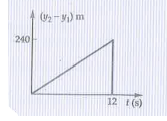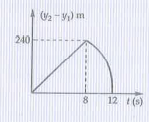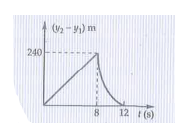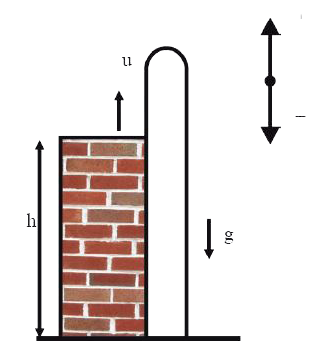Two stones are thrown up simultaneously from the edge of a cliff 240m high with initial speed of 10m/sand40m/s respectively . Which of the following graph best represents the time variation of relative position of the speed stone with respect to the first ?
( Assume stones do not rebound after hitting the groumd and neglect air resistance , take g=10m/s2)
( The figure are schematic and not drawn to scale )
v2−yi.
y2−y1.
y2−y.
yj−yi
Step by step video & image solution for Two stones are thrown up simultaneously from the edge of a cliff 240 m high with initial speed of 10 m//s and 40 m//s respectively . Which of the following graph best represents the time variation of relative position of the speed stone with respect to the first ? ( Assume stones do not rebound after hitting the groumd and neglect air resistance , take g = 10 m//s^(2)) ( The figure are schematic and not drawn to scale ) by Physics experts to help you in doubts & scoring excellent marks in Class 11 exams.
Updated on:21/07/2023Topper's Solved these Questions
Similar Questions
A cyclist moving on a circular track of radius 100 m completes one revolution in 4 minutes What is his average speed ?
View SolutionThe length of a suspended loire increases by 10−4 of its original length when a stress of 107Nm−2 is applied on it. Calculate the Young's modulus of the material of the wire.
View SolutionWhich of the following quantities are independent of the choice of orientation of the coordinate axes : →a+→, 3ax+2by, ∣∣→a+→b−→c∣∣, angle between →b and →c , λ→a , where λ is a scalar ?
View SolutionTwo stones are thrown up simultaneously from the edge of a cliff 240 m high with initial speed of 10 m//s and 40 m//s respectively . Which of the following graph best represents the time variation of relative position of the speed stone with respect to the first ? ( Assume stones do not rebound after hitting the groumd and neglect air resistance , take g = 10 m//s^(2)) ( The figure are schematic and not drawn to scale )
View SolutionTwo stones are thrown up simultaneously from the edge of a cliff with initial speed vand2v. The relative position of the second stone with respect to first varies with time till both the stones strike the ground as.
View SolutionTwo stones are thrown up simultaneously from the edge of a cliff 200 m high with initial speeds of 15 m s^(-1) and 30 m s^(-1) respectively. The time variation of the relative position of the second stone will request to the first as shown in the figure. The equation of the linear part is
View SolutionTwo stones are through up simultaneously from the edge of a cliff 240 m high with initial speed of 10 m/s and 40 m/s respectively. Which of the following graphs best represents the time variation of relative position of the second stone with respect to the first? Assume stones do not rebound after hitting the ground and neglect air resistance, take . g=10m/s2 (The figures are schematic and not drawn to scale)
View SolutionTwo stones are through up simultaneously from the edge of a cliff 240 m high with initial speed of 10 m/s and 40 m/s respectively. Which of the following graphs best represents the time variation of relative position of the second stone with respect to the first? Assume stones do not rebound after hitting the ground and neglect air resistance, take . g= 10 m//s^(2) (The figures are schematic and not drawn to scale)
View SolutionTwo stones are thrown up simultaneously from the edge of a cliff 240 m high with initial speeds of 10 m/s and 40 m/s respectively. Which of the following graphs best represents the time variation of relative position of the second stone with respect to the first?
(Assume stones do not rebound after hitting the ground and neglect air resistance take g = 10 m/s2 ) The figures are schematic and not drawn to scale)
View SolutionTwo stones are thrown up simultaneously from the edge of a cliff 240 m high with initial speed of 10 m/s and 40 m/s respectively. Which of the following graph best represents the time variation of relative position of the second stone with respect to the first ?
(Assume stones do not rebound after hitting the ground and neglect air resistance, take g = 10 m/s2 ). (The figures are schematic and not drawn to scale)
View SolutionTwo stones are thrown up simultaneously from the edge of a cliff 200 m high with initial speeds of 15 ms^(-1) and 30 ms^(-1) . Verify that the graph shown in Fig. correctly represents the time variation of the relative position of the second stone with respect to the first. Neglect air resistance and assume that the stones do not rebound after hitting the ground. Take g = 10 ms^(-2) . Give the equations for the linear and curved parts of the plot.
View SolutionA stone is thrown vertically up from the tower of height 25m with a speed of 20 m/s What time does it take to reach the ground ? (g=10m/s2)

View SolutionTwo stones are thrown up simultaneously from the edge of a cliff 200 m high with initial speeds of 15 ms^(- ) and 30 ms^(-1). Verify that the graph shown in figure. Correctly represents the time variation of the relative position of the second stone with respect to the first. Neglect air resistance and assume that the stones do not rebound after hitting the ground. Take g = 10 ms^(-2). Give the equations for the linear and curved parts of the plot.
View SolutionTwo stones are thrown up simultaneously from the edge of a cliff 200 m high with initial speeds of 15 m s^(-1) and 30 m s^(-1) respectively. The time variation of the relative position of the second stone with respect to the first is shown in the figure. The equation of the linear part is
View SolutionTwo stones are thrown up simultaneously from the edge of a clir 240 m high with initial speed of 10 m/s and 40 m/s respectively. Which of the following graphs best represents the time variation of relative position of the second stone with respect to the first? (Assume stones do not rebound after hitting the ground and neglect air resistance, take g=10 m/s^2 ) (The figures are schematic and not drawn to scale).
View SolutionTwo stones are thrown up simultaneously from the edge of a cliff with initial speed v and 2 v . The relative position of the second stone with respect to first varies with time till both the stones strike the ground as.
View Solution

